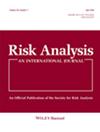对人工智能对蓄意生物威胁景观影响的风险分析。
IF 3
3区 医学
Q1 MATHEMATICS, INTERDISCIPLINARY APPLICATIONS
引用次数: 0
摘要
生物工程和人工智能(AI)的融合可能会增加生物风险的观点最近引起了人们对生物技术和人工智能治理的关注。2023年的行政命令《关于安全、可靠和可信赖地开发和使用人工智能的行政命令》要求对人工智能如何增加生物风险进行评估。从这个角度来看,定量和定性框架评估生物风险提出。这两个框架都使用概念场景进行了实践,然后讨论了它们的优点和局限性。最后,该观点总结指出,评估和评估方法必须与人工智能在生命科学领域的进步保持同步。本文章由计算机程序翻译,如有差异,请以英文原文为准。
Toward risk analysis of the impact of artificial intelligence on the deliberate biological threat landscape.
The perception that the convergence of biological engineering and artificial intelligence (AI) could enable increased biorisk has recently drawn attention to the governance of biotechnology and AI. The 2023 Executive Order, Executive Order on the Safe, Secure, and Trustworthy Development and Use of Artificial Intelligence, requires an assessment of how AI can increase biorisk. Within this perspective, quantitative and qualitative frameworks for evaluating biorisk are presented. Both frameworks are exercised using notional scenarios and their benefits and limitations are then discussed. Finally, the perspective concludes by noting that assessment and evaluation methodologies must keep pace with advances of AI in the life sciences.
求助全文
通过发布文献求助,成功后即可免费获取论文全文。
去求助
来源期刊

Risk Analysis
数学-数学跨学科应用
CiteScore
7.50
自引率
10.50%
发文量
183
审稿时长
4.2 months
期刊介绍:
Published on behalf of the Society for Risk Analysis, Risk Analysis is ranked among the top 10 journals in the ISI Journal Citation Reports under the social sciences, mathematical methods category, and provides a focal point for new developments in the field of risk analysis. This international peer-reviewed journal is committed to publishing critical empirical research and commentaries dealing with risk issues. The topics covered include:
• Human health and safety risks
• Microbial risks
• Engineering
• Mathematical modeling
• Risk characterization
• Risk communication
• Risk management and decision-making
• Risk perception, acceptability, and ethics
• Laws and regulatory policy
• Ecological risks.
 求助内容:
求助内容: 应助结果提醒方式:
应助结果提醒方式:


